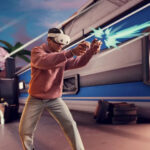How Businesses are Using Apple XR to Unlock Opportunities
Thanks to its high price tag, the Apple Vision Pro headset might have faced some early adoption challenges, but countless Apple XR Business case studies still highlight the benefits of the company’s extended reality ecosystem. Though pricey, the Vision Pro offers an incredible blend of next-level spatial computing features, immersive visuals, enterprise-grade apps, and privacy elements.
It’s widely regarded as one of the best mixed-reality headsets for enterprises, allowing organizations to tap into incredible experiences for immersive collaboration, product design, and data visualization. Now that Apple is building on its ecosystem with VisionOS updates, advanced AI, and partnerships with leaders like NVIDIA, the opportunities for companies are greater than ever.
Ready to discover what Apple XR can really do for your company? Here are some of the top case studies we recommend reading for a little inspiration.
The Top Apple Business XR Case Studies
When quantifying the benefits of enterprise technology, there’s no substitute for seeing first-hand what other companies have achieved. That’s why Apple XR business case studies are so valuable. They showcase the tangible returns brands across industries are getting from Apple’s world-leading “spatial computing” ecosystem.
From faster training for airline technicians to boosting the precision of auto racing analytics, Apple Vision Pro has proven its capacity to reshape processes, cut costs, and spark new ideas.
1. Porsche: Apple Business XR Case Studies in Automotive
Racing is about speed and precision. Gathering, analyzing, and acting on data in real-time can make the difference between winning and losing. Before the Vision Pro, race engineers working with Porsche had to rely on separate screens to access critical metrics.
The Porsche Race Engineer app, designed specifically to take advantage of the Vision Pro’s incredible resolution and data visualization features, introduced a new opportunity. With this app, engineers can see high-fidelity 3D content in real-time. During a track session, they can pull up speed and braking stats alongside track conditions, car positioning, and even live video feeds from the driver’s cockpit.
This mixed-reality setup clearly paid off when Porsche broke the US electric speed record in February with its new Taycan Turbo GT. Engineers were equipped with Vision Pro on the pit wall, combining data from multiple sensors and cameras.
Porsche isn’t the only company sharing Apple XR business case studies in the automotive space, either. In 2024, BMW also introduced new features to its BMW M mixed reality experience, using the Apple Vision Pro XR ecosystem.
2. KLM Royal Dutch Airlines: Streamlining Training
For companies exploring the role of MR, AR, and VR in the workplace, training is often a major use case. In various industries, XR technologies streamline the path to proficiency in technical skills by empowering users with hands-on training experiences and simulations.
KLM Airlines, struggling to train professionals on aircraft maintenance, needed a way to reduce downtime and the risk of human error during lessons. They created the KLM Engine Shop app with Apple Vision Pro’s VisionOS ecosystem.
This application allows users to overlay step-by-step instructions on a 3D model of any given engine. Trainees can walk around the virtual engine, zoom in, and see a detailed “blueprint” that updates in real time. This means technicians can practice tasks without even needing a physical plane.
According to the KLM VP of Operations and Decision Support, Bob Tulleken, the Vision Pro isn’t just improving fleet availability and operations, it’s helping tor educe costly errors. The system is making the team vastly more efficient in their work, while creating a better work environment, where all team members can learn, engage, and succeed.
3. Cromwell Hospital: Apple XR Business Case Studies in Healthcare
Healthcare is the prime ground for XR innovation. Operating rooms are crowded, and surgeons rely heavily on precise coordination. However, traditional tools for preoperative planning and real-time data display can be clunky. Cromwell Hospital was one of the first groups in the UK to leverage the benefits of the Apple XR ecosystem – even before the Vision Pro was rolled out to the UK.
Two surgeons at London’s Cromwell Hospital employed Apple Vision Pro as a “surgical logistics and organizational tool” using software from eXeX.
The platform lets surgical teams digitally map out procedures before making the first incision. Once inside the operating theater, the team can view interactive overlays, check patient vitals, and access digital checklists – all without manually handling screens or keyboards.
Elsewhere, various organizations are developing cutting-edge applications for healthcare training and patient care specifically built for the Vision Pro ecosystem. This could lead to countless companies worldwide investing in Vision Pro solutions to improve healthcare experiences.
4. NVIDIA: Merging Robotics, AI, and Spatial Computing
NVIDIA is one of the world’s leading computing experts, paving the way for a new era of AI, and innovation. It’s also one of the top companies supporting Apple XR business case studies today, thanks to a new partnership that brings Omniverse experiences and enterprise-grade streaming to the Vision Pro ecosystem.
At CES 2025, NVIDIA highlighted Apple’s Vision Pro as a key piece in its robotics and autonomous driving research. By leveraging the headset’s advanced sensors and ultra-high-resolution displays, NVIDIA’s developers can capture and stream real-world movements into Omniverse.
For instance, “Isaac GROOT,” an AI framework for humanoid robotics, uses real-time spatial data from Vision Pro to simulate and mimic human movements. Engineers can capture a user’s gestures and posture in 3D. This data means that robots then replicate human actions in either a virtual simulation or a live environment more effectively.
5. NatWest: Financial Services in Mixed Reality
Banking is a conservative industry when it comes to adopting radical new user experiences. Security concerns are paramount. However, NatWest wanted to explore how XR could improve customer experiences and financial education. NatWest tailored its existing mobile app for the Apple Vision Pro, leveraging Apple’s XR development ecosystem.
With the upgrade, users of MR devices can access immersive views of account balances, transactions, and even future spending projections. Plus, eye tracking and robust encryption protocols ensure that only the authenticated wearer can access sensitive information, minimizing the risk of privacy and compliance issues.
Users can literally “walk around” their financial data, highlight big expenses, and explore their credit scores in a panoramic layout. NatWest also integrated “Cora+,” its Generative AI assistant, into the XR environment. Customers can ask questions and receive hands-free, voice-based answers. The bank expects this system to reduce call center traffic as more people self-serve via the immersive app.
6. Siemens & BILT: Apple XR Business Case Studies in Frontline Work
Siemens, a global leader in industrial infrastructure, is always looking for ways to modernize workforce training and job execution. Onsite electricians and other frontline workers often grapple with intricate setups, high-voltage equipment, and tight deadlines. Mistakes can be dangerous and expensive. Fortunately, as leading Apple XR business case studies show, MR could be the answer.
Siemens partnered with BILT to deliver 3D Intelligent Instructions for Vision Pro. With interactive overlays, workers gain step-by-step guidance on installations, maintenance, and system checks. The platform uses Vision Pro’s eye and hand tracking and voice commands so users can rotate, zoom, and annotate digital twins in real-time.
This immersive approach makes it easier to cross-train employees or bring new hires up to speed. Siemens estimates the system helps reduce setup times by offering an always-available resource. Users no longer have to sift through PDFs and manuals – they can access insights instantly.
7. J.Crew: Revolutionizing Retail
Finally, one of the top Apple XR business case studies for the retail industry comes from fashion leader J.Crew. One of many companies embracing XR for virtual try-on experiences and unique customer experiences, J.Crew designed a dedicated app for Vision Pro.
The “J.Crew Virtual Closet” app for Apple Vision Pro offers a 3D mannequin for customers to style and examine from every angle. Users can “walk around” the virtual model and see how different pieces look in various combinations. The app also integrates SharePlay, so you can loop in a friend or a live stylist for feedback while you shop from home.
This leads to more confident purchases, cutting return rates. Early beta testers reported that seeing products in life-like 3D reduced doubts about fit and style. J. Crew is looking to expand the app to include dynamic lighting options, letting users see how an outfit might look in different environments.
Learning from Apple XR Business Case Studies
Each of these Apple XR Business Case Studies highlights a unique insight into how organizations use the Vision Pro and Apple software to streamline operations, reduce costs, train staff, or engage customers. Teams are speeding up processes, making fewer errors, and creating more engaging customer experiences, all while enhancing employee performance.
Clearly, even if the Vision Pro might have suffered a few adoption issues, Apple’s XR ecosystem has endless value to offer. The technology will only continue to capture more attention now that Apple is investing in new AI innovations, VisonOS updates, and partnerships.
Quelle:


